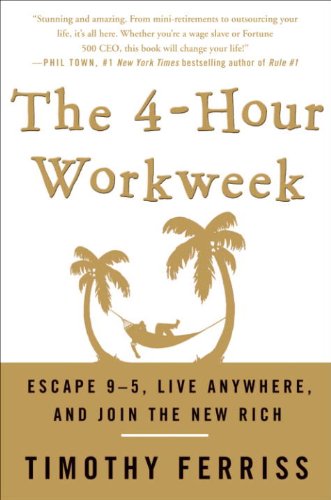 |
Author: Timothy Ferris
Pages: 308 |
"Escape 9-5, Live Anywhere, And Join The New Rich"
The subtitle of "the 4-hour work week" is certainly enticing, and the image of someone relaxing on a hammock conjures up plenty of fantastic images. Timothy Ferris' book on "Lifestyle Design" is an exercise in not judging a book by its cover. It may look like something that will be full of stories about driving Ferrari's and sipping cocktails out of coconuts (and it does have its fair share of stories), but under the surface there are some valuable lessons for any aspiring entrepreneur.
The core idea of the book is quite similar to the processing method of GTD - trash what you don't need, delegate whatever else you can and concentrate on the most important things that need doing. The book is divided into 4 different sections that explain the process involved in becoming a member of the New Rich.
1 - D for Definition
The first chapter of the book defines what the "New Rich" (NR) are. Members of the NR have other work for them, don't work for the sake of it and use the money they have to do the things they enjoy rather than waiting until they retire to do it.
The book mentions a "freedom multiplier" to try and explain the difference between conventional riches and NR riches. This takes into account what you do, when you do it, where you do it and and with whom. Using this you can see how someone that works 80 hours a week and makes $500k is in a worse position than someone that ears $40k but decides where and when they work.
The remainder of the chapter talks about various ideas for getting into an NR mindset, and then gives some exercises on "resetting" your system. The final part involves creating a "Dreamline" to visualise what you want out of life and what it will take to get there.
2 - E is for Elimination
Once you've decided what you want, it's time to create space in your life to achieve it. The elimination chapter covers the Pareto principle (the 80/20 rule), and also gives strategies for cutting as much waste as possible. This involves asking yourself questions like "If I had 2 hours to work a day, what would I do?" and "Am I being productive or just active?"
Next on the agenda is the low-information diet. This involves cutting out newspapers, magazines, news websites, TV shows and web surfing. There's a challenge for going on a one-week media fast to show just how unnecesary all of these things are.
Finally there are tips on adopting an attitude that stops people from bothering you. These range from simply being more assertive by asking "What can I do for you?" to sending out emails letting people know you only check mail once a week.
3 - A is for Automation
A key part of the automation strategy is outsourcing as much as you can. This ties in with chapter 2's theme of elimination; there's no point in outsourcing tasks that aren't that important.
The automation aspect eventually leads to the idea of removing yourself from income generation. The chapter takes you through the steps of finding an idea you'll enjoy, testing it to see if it will work and then delegating as much as possible to other people.
4 - Liberation
The final stage is to remove yourself from your job. This doesn't mean getting fired, but rather how to work towards being able to work remotely and how to do it once you get permission.
The closing part of this chapter also discusses the feelings you will encounter have once you've liberated yourself.
Thoughts
Don't let the title or writing style put you off, because there are some really useful strategies in the book. You may not end up living a four hour work week (or even a four hour work day), but the excercises can be enlightening.
The chapter on outsourcing is particulary interesting, mainly for the idea that you need to be comfortable with delegating tasks to other people. This can be a real hurdle, but it's worth overcoming.
The final few pages on coping with the change is worth reading on its own. It's easy to daydream about the amazing life you could have without having to work, but what happens when it comes true? Having another perspective on this is a real eye-opener, and if you have any interest in working for yourself I highly recommend you read it to get an idea of what's in store.